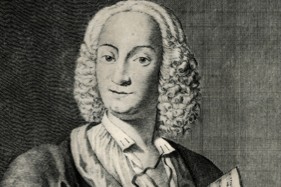Vivaldi, Antonio
Discover more about the composer of The Four Seasons

Vivaldi’s most famous surviving letter, the one in which, four years before his death in 1741, the composer mounts a defence of his artistic and moral reputation, is viewable only on the rare occasions when it is held in auction rooms prior to sale.
Fortunately, this letter was one of six written by Vivaldi to his noble patron Guido Bentivoglio d’Aragona that were published privately in 1871, so it has been used by biographers ever since to establish facts about the composer’s life.
In one paragraph Vivaldi writes of travelling during the previous 14 years to countless European cities in the company of his pupil, friend and assistant, the contralto Anna Girò.
He identifies some of the cities: Ferrara, where he had previously directed operas and was attempting, in the teeth of a ban by the city’s Cardinal, Tomaso Ruffo, to do the same again; Mantua, where he had been musical director to the Austrian governor from 1718 to 1720; Rome, where he had resided during three carnival seasons (including those of 1723 and 1724) and had played the violin in private to the Pope; and Vienna, where he had been summoned, presumably by the imperial court, on some prior occasion still unidentified.
All these ventures to distant cities would, at the time, have seemed perfectly natural for a violinist-composer who was also a composer of operas and who doubled as an impresario.
To acquire fame and patrons outside his native Venice, Vivaldi had to appear in public as a virtuoso of his instruments (violin and viola d’amore) and to perform concertos and sonatas of his own composition that were more challenging than those he chose to release for publication and circulation.
To ensure his operas were produced to his satisfaction, he had to be present at the theatres where they were staged and would ingratiate himself with the local nobility and supervise the box office.
Elsewhere in the same letter, however, Vivaldi mentions a fact that seems utterly incompatible with the life of a travelling virtuoso-cum-impresario.
Ever since birth, he suffered badly from bronchial asthma, for which he uses the term strettezza di petto, literally ‘tightness in the chest’.
Around 1706 asthmatic attacks forced him, as a newly ordained priest, to give up the lucrative practice of reciting Mass for the souls of benefactors of the Ospedale della Pietà, the home for foundlings whose all-female orchestra he directed.
In fact, as he writes, he gave up saying Mass in public for good. His medical condition caused him to stay at home, and to use a gondola or a carriage for locomotion rather than his own two feet.
So how did Vivaldi manage to travel around so freely outside Venice, in an age when such activity was slow, uncomfortable and often perilous? A large part of the credit must go to his loyal entourage. His chief assistant was his father, Giovanni Battista, who stayed at his side until his own death in 1736.
We know that Giovanni Battista accompanied him on a visit to Bohemia in 1729, since the elder Vivaldi obtained leave from his post as a violinist at St Mark’s specifically to join him.
Then there were Anna Girò and her half-sister Paolina, who acted as her companion and chaperone. Perhaps Vivaldi’s brothers and one or two family servants sometimes joined the party.
After 1713, when Antonio’s first opera, Ottone in villa, was produced in the mainland city of Vicenza, it was his operatic commitments that governed his movements.
He might have to ‘up sticks’ two or three times in a year: once for a carnival season in a city centre, and again for a spring or summer opera in a provincial centre. Vivaldi died, as he so often lived, in transit.
Arriving in Vienna in 1740 to take command at the Kärntnertor theatre, he was prevented from giving his opera L’oracolo in Messenia there in the following season on account of the public mourning and closure of all theatres decreed after the death of Emperor Charles VI.
Perhaps this setback brought on his death in July 1741.
Vivaldi was ill-reconciled to his chronic illness, and it seems his wanderlust was – quite literally – a displacement activity to compensate for the frustrations of his limited mobility in daily life.
In fact, one can argue that Vivaldi had a general preoccupation with mobility that left a distinct mark on his activities as violinist and composer.
Every demonstration of mobility was, as it were, one in the eye for his disability. Feeble though his legs and body may have been, Vivaldi’s fingers leaped up and down the violin’s fingerboard further and more rapidly than any of his contemporaries could manage.
Even his musical handwriting conveys the impression of abnormal speed and fluency.
But it was as a composer that Vivaldi gave vent to his obsession with mobility most forcefully.
The very layout of his scores expresses vigorous movement. Voices and instruments operate within unusually wide compasses, darting up and down, criss-crossing and causing the texture to transform itself constantly.
Instead of bunching his parts close together, Vivaldi likes to spread them wide open and thereby create extra room for manoeuvre.
In his melodic and accompanimental lines alike, wide intervals – typically, compound intervals (those more than an octave) – are privileged, such as the hiccupping ninths at the start of his Concerto funebre, RV 579.
We will understand Vivaldi better if we remember that he was a lifelong invalid who refused a sedentary existence, whether physical or psychical.
His ambition, his brazen self-confidence, his self-pity whenever his plans went awry, his suspicion of all but the favoured few, his resistance to collaborating with other musicians, his money-mania: all stemmed from a repressed insecurity born of a bodily ailment.
Every new composition, every successful operatic production, every demonstration of violinistic pyrotechnics was for him a token of his triumph over the odds.
Michael Talbot



